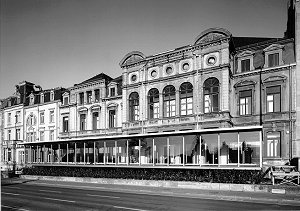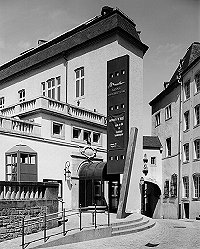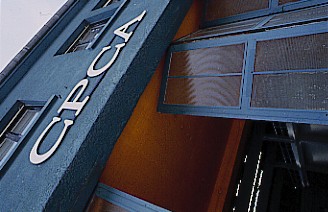




 VENUES
VENUES


 |
 |
Venues
- Casino Luxembourg - Forum d'art contemporain (map)

The building that houses the Casino Luxembourg - Forum d'art contemporain dates back to the 19th century, when the part of town it is located in corresponded to the wealthy promenade of the city. The "Casino Bourgeois", the name of which has been retained, was originally a place for social gatherings and cultural events. In 1995, the building hosted the main exhibitions of modern art for Luxembourg Ville europ»enne de la culture and since 1996 the building is used as a Kunsthalle for contemporary art exhibitions.
Twelve white cubes are inserted into the different rooms of the Casino Luxembourg, leaving the original architecture with its 19th-century stucco ceilings and hand painted walls and the architecture of the 1930s and 1950s untouched, yet changing the structure in such a way that the cubes provide a neutral exhibition space over 650 m2. In the 1950s, the original terrace which opened up onto the P»trusse valley was transformed into the Aquarium, a rectangular glass and steel cage affixed to the fa¡ade and inspired by the French modernist architect Jean Prouv».
41, rue Notre-Dame
L-2240 Luxembourg
Tél.: (+352) 22 50 45
Fax.: (+352) 22 95 95
- Musée d'Histoire de la Ville de Luxembourg (map)
The Mus»e d'Histoire de la Ville de Luxembourg is located in the historic area of Luxembourg. Opened in 1996, one of its principal architectural features is the strong verticality of its structure. The exposed masonry vaulting from the Middle Ages, which was rediscovered at the beginning of the 1990s, has been preserved and complemented by the architectural office Rep»rages from Paris in collaboration with the Luxembourgish architect Conny Lentz. Above ground, the museum consists of four former bourgeois houses dating from the 17th to the 19th century.
Starting three levels below ground, visitors can physically follow the historical layers of the architecture as they proceed from areas where the architecture itself is on display to the levels above ground where the buildings have become exhibition spaces. The former courtyard is now enclosed by glass and serves as the entrance hall to the museum. The museum's collections and its computer-assisted system document the city's architectural and urbanistic developments since the 10th century as well as its social, cultural and political history in the 19th and 20th centuries.
14, rue du Saint-Esprit
L-2090 Luxembourg
Tél.: (+352) 22 90 50-1
Fax.: (+352) 47 17 07
- Musée national d'histoire et d'art (map)

The Musée national d'histoire et d'art is located in the oldest part of town, in the so-called Fish Market. It is housed partly in a building from the late 19th century and connected to 16th, 17th and 18th century bourgeois houses.
The assemblage of these different buildings means that there is no real hierarchy in the alignment of rooms and exhibition spaces, which flow into each other in an almost organic manner. The museum becomes a maze-like succession of small rooms connected to each other with steps, small doorways, little bridges, cracking wood staircases and split levels. This eclectic architecture suits the diversity of the museum's collections which consist of archeological findings from the rich Roman and Celtic past of Luxembourg, ancient coins, furniture period rooms, and ancient as well as modern and contemporary art.
Marché.aux-Poissons
L-2345 Luxembourg
Té.: (+352) 47 93 30-208
Fax.: (+352) 47 93 30-271
- Villa Vauban-Galerie d'Art de la Ville de Luxembourg (map)
Built on the site of the late 17th-century Fort Vauban, one of the furthest outposts of the fortress, the so-called Villa Vauban is now located in the midst of the semi-circular row of parks surrounding the Luxembourg city center. The square plan, the evenly proportioned facades with tall and narrow windows, the sober ornamentation and the slate roof reflect the architectural style of French Neo-Classicism. Formerly the property of the wealthy Pescatore family, the Villa Vauban is now owned by the city and used as a space for temporary exhibitions, mostly of painting and sculpture as well as for the display of the permanent collection of old master paintings. The manicured garden, with its curving gravel pathways, small pond and wide open grass areas, is free for the artists of Manifesta 2 to realize their projects in.
- C.P.C.A. 12, rue du Puits (map)

The industrial building at 12, rue du Puits, originally constructed for a fruit and vegetable wholesale company and then used as a studio by a team of interior architects, is the rawest space of Manifesta 2. The building is presently being transformed so that it can be used by Manifesta 2. After Manifesta 2, the building will become the Centre de Production et de Cr»ation Artistique, a cultural centre for that part of town.
Unlike the other sites, it is not located in the centre of the city, but in the quartier de la Gare, the part of townsurrounding the train station. The building still carries the functional traits of its original purpose, such as a vast, open hall surrounded by storage areas and overlooked by a gallery of former offices, an indoor loading dock, and a large basement encircled by former cooling rooms.
For other venues in the City of Luxembourg you can look to our location map.
 |
|
|


